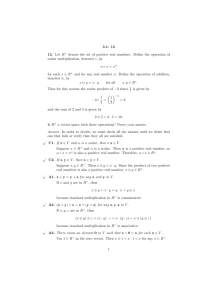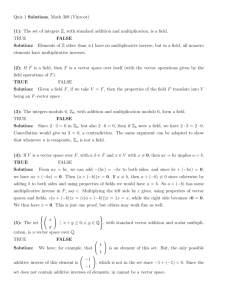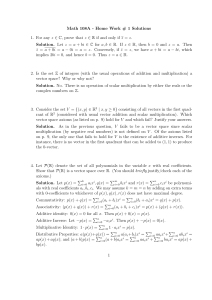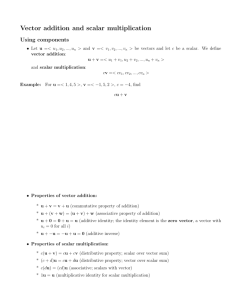MATH 110: LINEAR ALGEBRA FALL 2007/08 PROBLEM
advertisement
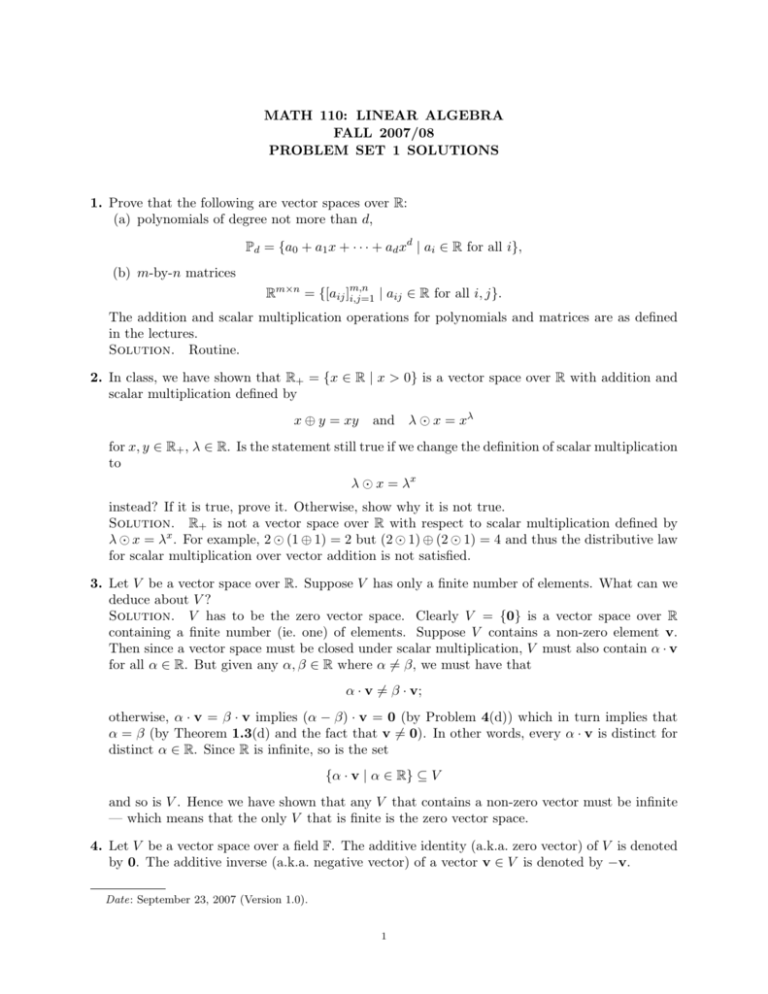
MATH 110: LINEAR ALGEBRA
FALL 2007/08
PROBLEM SET 1 SOLUTIONS
1. Prove that the following are vector spaces over R:
(a) polynomials of degree not more than d,
Pd = {a0 + a1 x + · · · + ad xd | ai ∈ R for all i},
(b) m-by-n matrices
Rm×n = {[aij ]m,n
i,j=1 | aij ∈ R for all i, j}.
The addition and scalar multiplication operations for polynomials and matrices are as defined
in the lectures.
Solution. Routine.
2. In class, we have shown that R+ = {x ∈ R | x > 0} is a vector space over R with addition and
scalar multiplication defined by
x ⊕ y = xy
and λ x = xλ
for x, y ∈ R+ , λ ∈ R. Is the statement still true if we change the definition of scalar multiplication
to
λ x = λx
instead? If it is true, prove it. Otherwise, show why it is not true.
Solution. R+ is not a vector space over R with respect to scalar multiplication defined by
λ x = λx . For example, 2 (1 ⊕ 1) = 2 but (2 1) ⊕ (2 1) = 4 and thus the distributive law
for scalar multiplication over vector addition is not satisfied.
3. Let V be a vector space over R. Suppose V has only a finite number of elements. What can we
deduce about V ?
Solution. V has to be the zero vector space. Clearly V = {0} is a vector space over R
containing a finite number (ie. one) of elements. Suppose V contains a non-zero element v.
Then since a vector space must be closed under scalar multiplication, V must also contain α · v
for all α ∈ R. But given any α, β ∈ R where α 6= β, we must have that
α · v 6= β · v;
otherwise, α · v = β · v implies (α − β) · v = 0 (by Problem 4(d)) which in turn implies that
α = β (by Theorem 1.3(d) and the fact that v 6= 0). In other words, every α · v is distinct for
distinct α ∈ R. Since R is infinite, so is the set
{α · v | α ∈ R} ⊆ V
and so is V . Hence we have shown that any V that contains a non-zero vector must be infinite
— which means that the only V that is finite is the zero vector space.
4. Let V be a vector space over a field F. The additive identity (a.k.a. zero vector) of V is denoted
by 0. The additive inverse (a.k.a. negative vector) of a vector v ∈ V is denoted by −v.
Date: September 23, 2007 (Version 1.0).
1
(a) Prove that
λ·0=0
for all λ ∈ F.
Solution. Note that
λ · 0 + λ · 0 = λ · (0 + 0) = λ · 0
where the first equality is by the distributivity of scalar multiplication over vector addition
and the second equality is by the property of the zero vector/additive identity. Now by the
existence of negative vector/additive inverse, we know that there is an element v ∈ V such
that
v + λ · 0 = 0.
(4.1)
Adding v to both sides of λ · 0 + λ · 0 = λ · 0 yields
v + (λ · 0 + λ · 0) = v + λ · 0.
(4.2)
The lhs of (4.2) may be simplied via
v + (λ · 0 + λ · 0) = (v + λ · 0) + λ · 0 = 0 + λ · 0 = λ · 0
(4.3)
where the equalities are due to the associativity of vector addition, the property of the negative vector/additive inverse, and the property of zero vector/additive identity. Substituing
(4.1) and (4.3) into (4.2) yields
λ·0=0
as required.
(b) Prove that
−(−v) = v
for all v ∈ V .
Solution. Note that
(−v) + v = 0 = v + (−v)
by the definition of −v. But this same equation also tells us that the additive inverse/negative
vector of −v, ie. −(−v), is v.
(c) Let the additive identity of F be denoted by 0 and the additive inverse of λ ∈ F be denoted
by λ0 (thus λ + λ0 = 0 = λ0 + λ in F). Prove that
λ · (−v) = −(λ · v) = λ0 · v
for all λ ∈ F and all v ∈ V . Note that there are two equalities to be proved.
Solution. First we will prove that
−(λ · v) = λ0 · v.
Note that
0 = 0 · v = (λ + λ0 ) · v = λ · v + λ0 · v
where the first equality is by Theorem 1.3(a), the second by the property of λ0 as the
additive inverse of λ ∈ F, and the third by distributivity of scalar multiplication over scalar
addition. Together with the commutativity of vector addition, we obtain
λ · v + λ0 · v = 0 = λ0 · v + λ · v
which means that λ0 · v is the negative vector/additive inverse of λ · v, ie.
λ0 · v = −(λ · v).
Next we will prove that
λ · (−v) = −(λ · v).
Note that
0 = λ · 0 = λ · (−v + v) = λ · (−v) + λ · v
2
where the first equality is by Problem 4(a), the second by the property of negative vector/additive inverse, the third by the distributivity of scalar multiplication over vector
addition. Together with the commutativity of vector addition, we obtain
λ · v + λ · (−v) = 0 = λ · (−v) + λ · v
which means that λ · (−v) is the negative vector/additive inverse of λ · v, ie.
λ · (−v) = −(λ · v).
(d) Recall that subtracting a vector v from a vector u is defined as adding the additive inverse
of v to u, ie. u − v = u + (−v). Prove that
λ · (u − v) = λ · u − λ · v
and
(λ − µ) · u = λ · u − µ · u
for all u, v ∈ V , λ ∈ F.
Solution. Note that
λ · u − λ · v = λ · u + [−(λ · v)]
= λ · u + λ · (−v)
= λ · [u + (−v)]
= λ · [u − v]
where the first and last equalities are by the definition of vector subtraction, the second
equality is by Problem 4(c), and the third equality is by the distributivity of scalar multiplication over vector addition.
For the second identity, note that
λ · u − µ · u = λ · u + [−(µ · u)]
= λ · u + µ0 · u
= (λ + µ0 ) · u
where the first equality is by the definition of vector subtraction, the second equality is by
Problem 4(c), and the third equality is by the distributivity of scalar multiplication over
scalar addition. Now just observe that −µ is just another (more common) way of writing
µ0 , the additive inverse of µ in F.
5. Let V be a vector space over R with addition and scalar multiplication denoted by + and ·
respectively. Let W = V × V = {(v1 , v2 ) | v1 , v2 ∈ V }. Prove that W is a vector space over C
with addition defined by
(u1 , u2 ) (v1 , v2 ) = (u1 + v1 , u2 + v2 )
for all (u1 , u2 ), (v1 , v2 ) ∈ W and scalar multiplication defined by
(v1 , v2 ) = (a · v1 − b · v2 , b · v1 + a · v2 )
√
for all a + bi ∈ C and (v1 , v2 ) ∈ W . Here i = −1 and a, b ∈ R.
Solution. Routine.
(a + bi)
3
